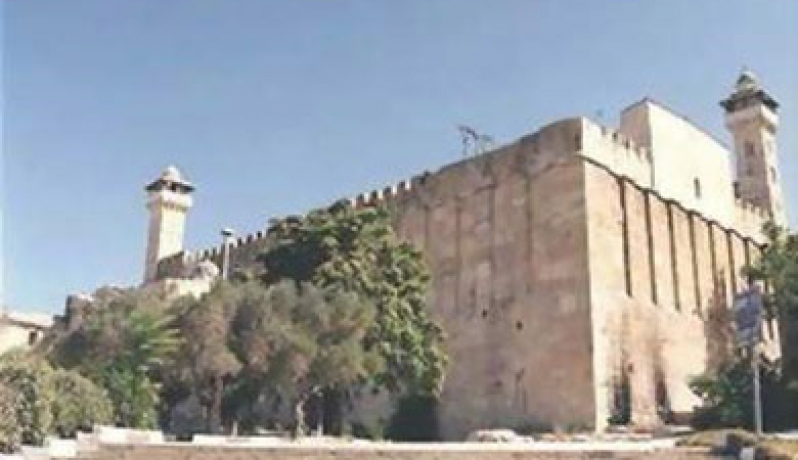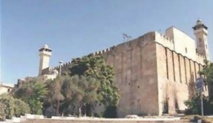Tradition has it that the bones of Abraham and Sarah, Isaac and Rebecca and Jacob and Leah lie buried here, making it a shrine for Jews, Christians and Muslims.
Known variously as the Cave of the Patriarchs, the Cave of Machpelah and the Ibrahimi Mosque, the site on the West Bank dates back 2,000 years.
"The mosque is an extremely historic and holy place for us," says Mohammed Fakuri, 24, a Palestinian tour guide and expert on the graves.
But Israeli historian Zipi Schlissel, 52, who works in a Jewish history museum just a few minutes away, disagrees. "It has never been a holy site for Palestinians and will never be one," she says. "It's a Jewish religious site."
The long-running conflict over the holy site has been stoked anew by UNESCO's decision last month to declare the Old Town of Hebron a World Heritage Site in response to an application by the Palestinian National Authority (PNA).
The UN's cultural and educational agency simultaneously placed the site on its "in danger" list on account of the Israeli occupation.
Israel has effectively controlled the West Bank since the 1967 Six-Day War, while devolving powers to the PNA.
Hebron - or al-Khalil to give it its Arab name, which means "friend" or "lover" - is home to around 210,000 inhabitants.
The PNA controls one part of the city, Israel the other, where some 800 Jewish settlers, including Schlissel, live among 50,000 Palestinians. It is in this sector that the holy site lies.
UNESCO now lists "Hebron/Al-Khalil Old Town" including the contested holy site under its World Heritage Sites in Palestine.
The Israeli government is outraged.
Prime Minister Benjamin Netanyahu calls it "another delusional decision by UNESCO," adding that the connection between the people of Israel and Hebron reaches back thousands of years and is without parallel in human history.
Schlissel cites the Bible. "Hebron is repeatedly mentioned as a Jewish area," the mother of 11 says. Her headscarf and black dress mark her out as among the more Orthodox of the Jewish faith.
Abraham is said to have paid 400 shekels for the land, and David ruled as king from Hebron before moving his capital to Jerusalem.
"Everyone who knows their history knows that Herod built this building," she says, terming the UNESCO decision "anti-Semitic."
There are two entrances. In front of the mosque, Israeli soldiers armed with assault rifles are checking a group of Palestinian youth, one of whom lifts his T-shirt and turns to show he is not armed.
Two young women in headscarves descend the stairs.
A soft red carpet covers the floor in the main room. Ornate columns support the high ceiling, with a gallery running along the walls.
Fakuri, in a white T-shirt and jeans with carefully styled hair, is positive about the UNESCO decision. "More visitors will come than previously, because it is now a significant site," he says.
He blames the relatively few visitors currently on "fear of the Israeli checkpoints."
Hebron has long been a source of conflict. Shortly after the start of the most recent wave of violence in the autumn of 2015, a third of all the attackers came from Hebron.
The Palestinian group Youth Against Settlements says there are 20 Israeli checkpoints in the city.
At the entrance to the synagogue, men in black hats and with side locks, girls in dresses and women in wigs - the signs of Orthodox Judaism - stand waiting for the buses to take them away again. A soldier sits in a guardhouse.
The synagogue is in the inner courtyard under a beige pavilion roof. As children run across the stone floor, men are swaying in prayer in the front, while the women pray at the rear, separated by a partition.
"Hebron is part of Palestine, from a physical viewpoint and according to international agreement," says Ahmed Rajub of the Palestinian Tourism Ministry. "We are responsible for the cultural heritage here."
But he is also aware that the graves of the patriarchs are of religious significance, not only for the Palestinians, "but for the whole of humanity."
The site needs to be protected from the Israeli occupation, Rajub says, pointing to the Israeli Army guardhouse at the entrance to the mosque and the new houses of the settlers in the Old Town.
Rajub is banking on the annual reports issued by UNESCO regarding developments at the site and on greater international attention in general. One aim is to seek UNESCO's support in securing funding.
Political scientist Menachem Klein also rejects Netanyahu's criticism, saying the agreement that UNESCO denies a Jewish connection is false.
The professor at Bar Ilan University near Tel Aviv notes that UNESCO has stressed the significance of the site for Jews and Christians.
Asked what has changed as a result of declaring the Cave of the Patriarchs a World Heritage Site, Klein's answer is terse: "Nothing."
-----------------------------------------------------------------------------------------------------------------------
Known variously as the Cave of the Patriarchs, the Cave of Machpelah and the Ibrahimi Mosque, the site on the West Bank dates back 2,000 years.
"The mosque is an extremely historic and holy place for us," says Mohammed Fakuri, 24, a Palestinian tour guide and expert on the graves.
But Israeli historian Zipi Schlissel, 52, who works in a Jewish history museum just a few minutes away, disagrees. "It has never been a holy site for Palestinians and will never be one," she says. "It's a Jewish religious site."
The long-running conflict over the holy site has been stoked anew by UNESCO's decision last month to declare the Old Town of Hebron a World Heritage Site in response to an application by the Palestinian National Authority (PNA).
The UN's cultural and educational agency simultaneously placed the site on its "in danger" list on account of the Israeli occupation.
Israel has effectively controlled the West Bank since the 1967 Six-Day War, while devolving powers to the PNA.
Hebron - or al-Khalil to give it its Arab name, which means "friend" or "lover" - is home to around 210,000 inhabitants.
The PNA controls one part of the city, Israel the other, where some 800 Jewish settlers, including Schlissel, live among 50,000 Palestinians. It is in this sector that the holy site lies.
UNESCO now lists "Hebron/Al-Khalil Old Town" including the contested holy site under its World Heritage Sites in Palestine.
The Israeli government is outraged.
Prime Minister Benjamin Netanyahu calls it "another delusional decision by UNESCO," adding that the connection between the people of Israel and Hebron reaches back thousands of years and is without parallel in human history.
Schlissel cites the Bible. "Hebron is repeatedly mentioned as a Jewish area," the mother of 11 says. Her headscarf and black dress mark her out as among the more Orthodox of the Jewish faith.
Abraham is said to have paid 400 shekels for the land, and David ruled as king from Hebron before moving his capital to Jerusalem.
"Everyone who knows their history knows that Herod built this building," she says, terming the UNESCO decision "anti-Semitic."
There are two entrances. In front of the mosque, Israeli soldiers armed with assault rifles are checking a group of Palestinian youth, one of whom lifts his T-shirt and turns to show he is not armed.
Two young women in headscarves descend the stairs.
A soft red carpet covers the floor in the main room. Ornate columns support the high ceiling, with a gallery running along the walls.
Fakuri, in a white T-shirt and jeans with carefully styled hair, is positive about the UNESCO decision. "More visitors will come than previously, because it is now a significant site," he says.
He blames the relatively few visitors currently on "fear of the Israeli checkpoints."
Hebron has long been a source of conflict. Shortly after the start of the most recent wave of violence in the autumn of 2015, a third of all the attackers came from Hebron.
The Palestinian group Youth Against Settlements says there are 20 Israeli checkpoints in the city.
At the entrance to the synagogue, men in black hats and with side locks, girls in dresses and women in wigs - the signs of Orthodox Judaism - stand waiting for the buses to take them away again. A soldier sits in a guardhouse.
The synagogue is in the inner courtyard under a beige pavilion roof. As children run across the stone floor, men are swaying in prayer in the front, while the women pray at the rear, separated by a partition.
"Hebron is part of Palestine, from a physical viewpoint and according to international agreement," says Ahmed Rajub of the Palestinian Tourism Ministry. "We are responsible for the cultural heritage here."
But he is also aware that the graves of the patriarchs are of religious significance, not only for the Palestinians, "but for the whole of humanity."
The site needs to be protected from the Israeli occupation, Rajub says, pointing to the Israeli Army guardhouse at the entrance to the mosque and the new houses of the settlers in the Old Town.
Rajub is banking on the annual reports issued by UNESCO regarding developments at the site and on greater international attention in general. One aim is to seek UNESCO's support in securing funding.
Political scientist Menachem Klein also rejects Netanyahu's criticism, saying the agreement that UNESCO denies a Jewish connection is false.
The professor at Bar Ilan University near Tel Aviv notes that UNESCO has stressed the significance of the site for Jews and Christians.
Asked what has changed as a result of declaring the Cave of the Patriarchs a World Heritage Site, Klein's answer is terse: "Nothing."
-----------------------------------------------------------------------------------------------------------------------









 Home
Home Politics
Politics











